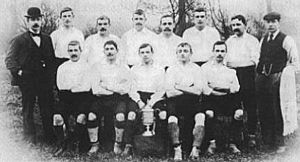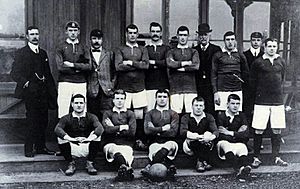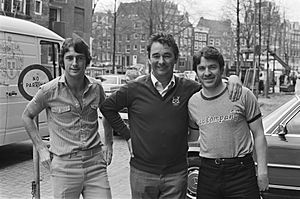History of Nottingham Forest F.C. facts for kids
Nottingham Forest Football Club has a long and exciting history, starting way back in 1865. Over the years, Forest has won many important trophies, including one league title, two FA Cups, four League Cups, two European Cups, and one UEFA Super Cup. They are one of the most famous football clubs in England!
Contents
History of Nottingham Forest
How it All Began (1865-1900)
In 1865, a group of friends who played a game called shinty decided to try football instead. They met at a place called the Clinton Arms in Nottingham and formed Nottingham Forest Football Club. They also decided the team's colours would be 'Garibaldi Red', named after brave Italian freedom fighters. Forest's very first official game was against their local rivals, Notts County, on March 22, 1866.
In their early days, Forest wasn't just about football. They also had a successful baseball team that won the British championship in 1899! Forest was also very kind to other clubs. They even donated football kits to help clubs like Arsenal get started in 1886. Arsenal still wears red today because of Forest's generosity! Forest also helped Everton and Brighton & Hove Albion get going.
Forest first played in the FA Cup in 1878–79. They reached the semi-finals but didn't win. In 1889, Forest joined the Football Alliance and won it in 1892, which helped them join the main Football League.
Forest won their first major trophy, the FA Cup, in 1898. They beat Derby County 3–1 in the final at Crystal Palace. Arthur Capes scored two goals, and John McPherson scored the winning goal. It was a huge moment for the club!
Into the 20th Century (1900-1974)
After their FA Cup win, Forest had some ups and downs. They reached more FA Cup semi-finals but didn't win them. They finished high in the league for a couple of seasons but then started to drop down. In 1905–06, they were relegated for the first time. But they bounced back quickly, winning promotion in 1906–07.
In 1905, Nottingham Forest even went on a special trip to South America to play friendly matches in Argentina and Uruguay. This helped spread football in those countries!
The club faced financial problems around World War I, but they managed to keep going. They were promoted back to the top division in 1921–22 but were relegated again in 1924–25. They spent many years in the second division and even dropped to the third division in 1949.
Forest quickly returned to the second division in 1950–51, scoring a record 110 goals! They then made it back to the top division in 1957.
In 1959, Forest won the FA Cup again! They beat Luton Town 2–1 in the final at Wembley. Roy Dwight and Tommy Wilson scored early goals. Forest faced challenges during the game, including Dwight breaking his leg, but they bravely held on to win. This was a fantastic achievement for the club.
In the 1966–67 season, Forest had a great team and almost won the league title, finishing second to Manchester United. They also reached the FA Cup semi-finals again. However, after this successful period, the club's performance declined, and they were relegated from the top division in 1972.
The Brian Clough and Peter Taylor Glory Years (1975–1982)
A very important moment in Forest's history happened on January 6, 1975, when Brian Clough became the new manager. He brought his trusted assistant, Peter Taylor, to the club in 1976. Taylor was great at finding new talent. He helped players like John Robertson and Tony Woodcock become stars. They also signed key players like Peter Shilton (a fantastic goalkeeper) and Kenny Burns (who became a great defender).
Their first trophy together was the 1976–77 Anglo-Scottish Cup in December 1976. Clough believed winning this trophy was very important for the team's confidence.
In the 1976–77 season, Forest won promotion to the top division! This was a huge step for the club.
Then came the most amazing period in Forest's history. In the 1977–78 season, Forest won the First Division title, becoming champions of England! They did this just one season after being promoted, which is incredibly rare. They lost only three league games all season and also won the League Cup by beating Liverpool.
Forest continued their success in the 1978–79 season. They won the FA Charity Shield with a huge 5–0 win. They also kept the League Cup, beating Southampton 3–2 in the final. In February 1979, Forest made history by signing Trevor Francis for £1 million, the first time a British club paid so much for a player.
The biggest achievements came in Europe. In the 1978–79 European Cup, Forest beat the mighty Liverpool team and then went all the way to the final. They played Malmö in Munich and won 1–0, with Trevor Francis scoring the winning goal! Nottingham Forest were champions of Europe!
The next season, 1979–80, Forest continued their European dominance. They won the 1979 European Super Cup against Barcelona. They also reached the European Cup final again, this time beating Hamburg 1–0 in Madrid, with John Robertson scoring the goal. Forest had won the European Cup twice in a row!
After these incredible years, the team started to change. Many of the star players were sold, which Clough and Taylor later said was a mistake. By 1982, most of the European Cup-winning players had left. At the end of the 1981–82 season, Peter Taylor retired, ending a legendary partnership.
Brian Clough Continues (1982–1993)
Brian Clough continued as manager alone. In the 1982–83 season, Forest finished fifth in the league, earning a place in the UEFA Cup. The next season, 1983–84, they almost won the league again, finishing third. They also reached the UEFA Cup semi-finals, but lost in controversial circumstances to Anderlecht, who were later found to have been involved in unfair practices.
English clubs were banned from European competitions after 1985 due to the Heysel disaster, so Forest couldn't play in Europe even when they qualified. Clough rebuilt the team with new talents like Des Walker, Steve Hodge, his son Nigel, and Stuart Pearce.
In the 1988–89 season, Forest finished third in the league again. They also won the League Cup, beating Luton Town 3–1 at Wembley. Brian Clough caused some controversy during a cup game by reacting strongly to fans on the pitch, which led to a fine.
Tragedy struck in April 1989 at the Hillsborough disaster during an FA Cup semi-final against Liverpool, where 96 Liverpool fans sadly lost their lives. The match was abandoned and replayed later.
In 1989–90, Forest won the League Cup again, beating Oldham Athletic 1–0. In 1990–91, Forest reached the FA Cup final, the only major domestic trophy Brian Clough had never won. They lost 2–1 to Tottenham Hotspur in a memorable game.
In 1991–92, Forest signed Teddy Sheringham for a club record fee. They reached another League Cup final, losing to Manchester United, and also won the Full Members Cup. Forest finished eighth in the league, which meant they qualified for the brand new FA Premier League.
However, the 1992–93 season was tough. Sheringham was sold early in the season, and without his goals, Forest struggled. They spent most of the season at the bottom of the Premier League. In April, it was announced that Brian Clough would retire at the end of the season after 18 years. His amazing reign ended with Forest being relegated.
Brian Clough is still Nottingham Forest's most successful manager. Most of the club's major trophies were won under his leadership. The Executive Stand at the City Ground is now called the Brian Clough Stand, and there's a statue of him in Nottingham. In 2015, the main stand was renamed the Peter Taylor Stand to honour his contribution.
New Managers and Challenges (1993–2011)
After Brian Clough, former Forest player Frank Clark became manager in May 1993. He quickly led Forest back to the Premier League in his first season! In 1994–95, Forest had a fantastic return, finishing third in the Premier League and qualifying for the UEFA Cup. They even beat Manchester United at Old Trafford! However, key player Stan Collymore was sold, and Forest's form dipped. Clark was sacked in December 1996.
Stuart Pearce, the team captain, took over temporarily and helped the team improve. But the club wanted someone more experienced, so Dave Bassett became manager in March 1997. Forest were relegated that season. They won promotion back to the Premier League in 1997–98, but key players left, and Bassett was sacked in January 1999.
Ron Atkinson took over briefly in 1999 but couldn't save Forest from relegation again. They finished bottom of the Premier League.
David Platt, a former England captain, became player-manager in July 1999. He made some expensive signings, but Forest struggled with financial problems and couldn't get back to the Premier League. Platt left in 2001.
Paul Hart took over in 2001. The club faced serious financial issues, but Hart helped them finish sixth in the First Division in 2002–03, reaching the play-offs. However, they lost in the semi-finals. Hart was sacked in February 2004.
Joe Kinnear became manager in 2004 and helped the team improve, but he left in December after a poor start to the next season. Gary Megson then took charge in January 2005, but Forest were relegated to League One, the third tier of English football. This was a sad moment as they were the first European Cup winners to drop so low. Megson left in February 2006.
Frank Barlow and Ian McParland took over as caretakers and had a great run, winning many games and almost reaching the play-offs.
Colin Calderwood became manager in May 2006. Forest had some good runs and reached the play-offs in 2006–07 but lost again. In 2007–08, Forest finally won promotion back to the Championship on the last day of the season! They finished second in League One. Calderwood was sacked in December 2008 after inconsistent results.
Billy Davies became manager in January 2009. He helped Forest avoid relegation from the Championship. In 2009–10, Forest had a fantastic season, staying in the top three for most of the time and setting a club record for home wins. They reached the play-offs but lost to Blackpool. In 2010–11, they reached the play-offs again but lost to Swansea City.
A Decade of Change (2011–2021)
After Billy Davies, Steve McClaren became manager in June 2011. However, he resigned in October 2011 due to disagreements over new player signings. The club then went through a period with many different managers.
In February 2012, former chairman Nigel Doughty sadly passed away. In July 2012, the Al-Hasawi family bought Nottingham Forest. They quickly made changes, including sacking manager Steve Cotterill.
Sean O'Driscoll was appointed manager in July 2012 but was sacked on Boxing Day, just hours after a win! Alex McLeish took over but left after only 40 days.
Billy Davies returned as manager in February 2013. Forest started the 2013–14 season strongly but Davies was sacked in March 2014.
Another former player, Stuart Pearce, became manager in July 2014. Forest started very well, even topping the Championship table, but their form dropped, and Pearce was sacked in February 2015.
Dougie Freedman took over, followed by Paul Williams as caretaker. In June 2016, Philippe Montanier became manager but was sacked in January 2017.
Mark Warburton was appointed in March 2017. In May 2017, Evangelos Marinakis completed his takeover of Nottingham Forest, ending the Al-Hasawi family's ownership. Warburton was sacked in December 2017.
Aitor Karanka became manager in January 2018. He made many new signings, and the team improved, but Karanka left in January 2019.
Club legend Martin O'Neill took over, with Roy Keane as his assistant. However, O'Neill was sacked in June 2019.
Sabri Lamouchi became manager and led Forest to a strong season in 2019–20. They were in a play-off spot for a long time but lost it in the very last minute of the final game. Lamouchi was sacked early in the 2020–21 season.
Chris Hughton took over in October 2020 and helped Forest avoid relegation. But after a poor start to the 2021–22 season, Hughton was sacked in September 2021, with Forest at the bottom of the table.
Steve Cooper Renaissance (September 2021–Present)
Steve Cooper was appointed manager on September 21, 2021. He immediately brought about a huge change in the club's fortunes. Forest started winning games and quickly climbed up the league table.
In January 2022, Forest had a memorable FA Cup win, beating Premier League giants Arsenal 1–0 at home.
On May 29, 2022, Nottingham Forest won the play-off final against Huddersfield Town! This incredible victory meant Forest were promoted to the Premier League for the 2022–23 season. It was their first time back in the top division in 23 years! Steve Cooper was highly praised for taking the club from the bottom of the league to promotion in just one season.
|
See also
 In Spanish: Historia del Nottingham Forest Football Club para niños
In Spanish: Historia del Nottingham Forest Football Club para niños





